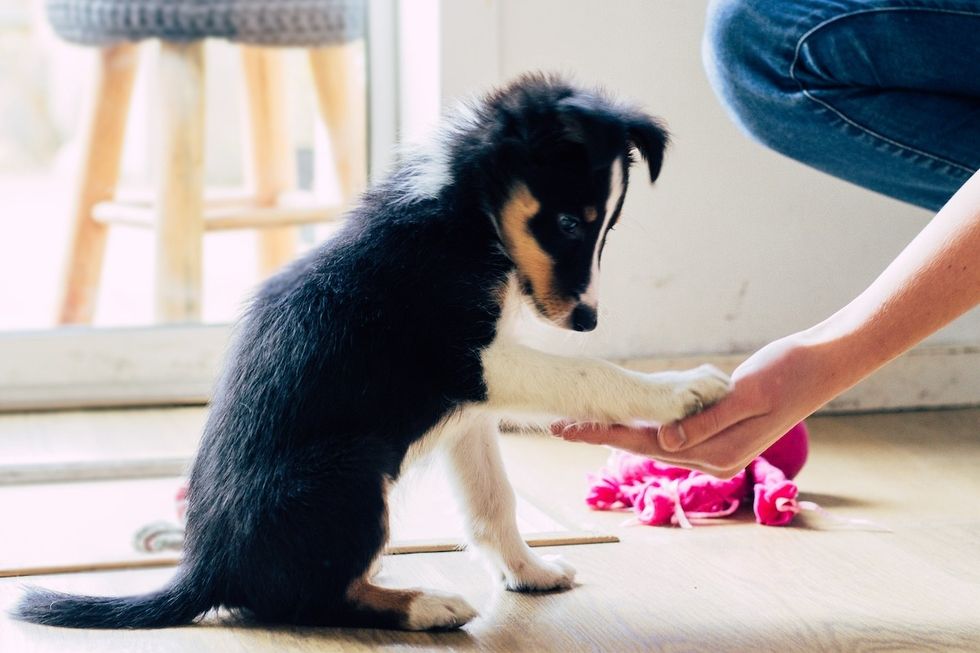Making the decision to adopt a new puppy can be an exciting and heartwarming time as you get to know the latest addition to your family. But besides all of the playing and cuddling, it also comes with plenty of work and responsibility as you begin to train them. Establishing this early in a dog’s life can be one of the best ways to ensure they’ll feel at ease—not to mention make your life as a pet parent even easier. And if you’re looking for a good place to get started, a dog trainer has revealed her top three “underrated” puppy training tips that can help simplify the process.
RELATED: Top 5 Most Difficult Dog Breeds to Potty Train, Veterinarian Says.
In a recently posted video, TikTok user Taylor Cezanne shares a handful of tricks to keep in mind when you take a new puppy into your home. Her first recommendation is to set up random treat stations around your house so you’ll always be able to turn a moment into a learning opportunity.
“I always keep one right by my couch because when I’m watching the puppy play, and they’re doing something that I really like, I will reinforce it and toss a treat!” she says. “I like to keep another by their crate because I can always drop one in if I want the puppy to go to the crate.”
She adds that you can get a little more creative with where you stash your dog’s rewards. “Put these babies in the kitchen, in the bedroom, anywhere where your puppy is going to be, and you can constantly reinforce good behavior,” she suggests. “And they don’t even know that it’s coming! Treats are just raining from the sky, and they love it.”
This can also have the bonus effect of spacing out their learning time. “Training them in five- to 10-minute increments is sometimes way better—if not all the time—than a whole 30-minute session,” she says.
For her next tip, Cezanne gets a little more pragmatic and considers the big picture, suggesting that owners change their perspective on training mistakes.
“You will not be the perfect pet parent, and your dog is not going to be a perfect dog either. Mistakes will happen, and that is OK!” she says. “The goal is not to have a perfect dog, but a happy one.”
Cezanne explains that instead of becoming frustrated when your initial training method doesn’t work, you should use it as an opportunity to alter your approach—and not lose hope.
“If they’re having trouble with potty training or if they’re jumping on people with muddy paws, I know it’s frustrating, [but] maybe we teach them to sit instead of jumping up on someone,” she says. “Maybe we wake up 20 minutes earlier and take them out so they don’t make a mistake on the floor. But look at it for what it is: An opportunity to try again tomorrow.”
RELATED: Cesar Millan Says You Should Never Walk Behind Your Dog—Here’s Why.
She then goes on to reveal what she says is probably the most important tip: Give your puppy time to take a nap.
“Teach them how to settle down!” she tells viewers.
Cezanne says the best way to do this is to follow a puppy routine. Specifically, this involves putting the puppy in a crate with a blanket over it when it’s time to go to bed.
“You need to go through the puppy routine so that they’re physically and mentally taken care of, and then you put them here with that blanket over it—that’s the trick!” she says
She even has a schedule for how many hours your puppy can stay in their crate, depending on their age. It starts for dogs that are eight to 10 weeks with a limit of one to two hours, growing incrementally up through adolescence at 21 to 24 weeks, where five to six hours is appropriate. She clarifies that this isn’t per day, it’s per “period of time.”
She also suggests using a timer to stay within the guidelines and to keep an eye on your pet while they’re adjusting. If two hours is too long for your young puppy, she suggests cutting back the time to 90 minutes or even an hour.
“It may be challenging at first, but I promise you that your puppy is going to learn that they sleep in [their crate] and relax. And I want you to wake up before they wake you up, OK?” she adds.

